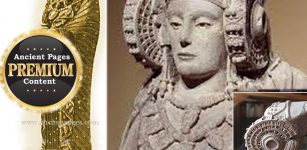Magnificent Hattusa: Capital Of The Hittite Empire
A. Sutherland - AncientPages.com - Hattusa was the capital of the kingdom of the Hittites in the late Bronze Age. In the 2nd millennium BC, the kingdom stretched from the Aegean across Anatolia, Turkey, northern Syria, and to the Euphrates River.
In ancient times, it was a great city, and even today, its magnificent ruins attest to the greatness of this place. The population of the old capital is estimated to have been 50,000 at its most.
 Hattusa is one of Turkey’s great ruins of the capital of the Hittite Empire.
Hattusa is one of Turkey’s great ruins of the capital of the Hittite Empire.
Hattusa has a rich history with its six-kilometre walls surrounding the ancient city, its monumental gates, the 71-meter-long underground passage, and 31 temples unearthed so far. The Lion Gate, the King Gate, and the Yazılıkaya Open Air Temple are some of the impressive landmarks.
The first settling around Hattusa took place in the 6th millennium BC during the Chalcolithic period, when small, widely scattered hamlets appeared, most particularly on mountain slopes and rocky outcroppings. Late in the 3rd millennium BC, towards the end of the Early Bronze Age, a Hattian settlement developed, marking the beginning of continuous occupation at the site.
 Hattusha - The King Gate Image credit: Wikipedia
Hattusha - The King Gate Image credit: Wikipedia
The Hittites ruled the central Anatolian kingdom of Hatti from c. 1900 - to 800 BCE. They formed the earliest known Anatolian civilization and employed an advanced system of government based on an established legal system. Their military force was well trained, well equipped, and employed chariots that were the lightest and fastest of their time.
Hattusa consists of two sites: the Lower City and the Upper City. The Hittites built their capital on a site that could be well defended.
The ruins of the upper city’s fortification reveal that the city was surrounded by a double wall (forming a perimeter of roughly 8 km) with more than a hundred towers and, as far as is known today, five gateways: two in the west, Lion’s Gate in the south-west, the King’s Gate in the south-east and a procession gate, the Sphinx Gate in the south of the city.
 Hattusa - The Lion Gate in the south-west. Image credit: Bernard Gagnon - CC BY-SA 2.5
Hattusa - The Lion Gate in the south-west. Image credit: Bernard Gagnon - CC BY-SA 2.5
To the north, beyond the walls, there was a necropolis cut into the rock at Osmankayasi and the great sanctuary of Yazilikaya, whose walls decorated with bas-reliefs are the undisputed masterpiece of Hittite art.
Hattusa - The Sphinx Gate. Adobe Stock - marista
The best-preserved ruin of a Hittite Temple from the 13th century B.C., known as the Great Temple, is located in the Lower City. The Great Temple was dedicated to the god of storms and the goddess of the Sun, Arinna, and surrounded by an array of buildings, including stores.
Thousands of cuneiform tablets were found in this area. One of the most important discoveries has been the cuneiform royal archives of clay tablets, consisting of official correspondence and contracts, legal codes, procedures for cult ceremonies, oracular prophecies, and literature of the ancient Near East.
One particularly important tablet, currently on display at the Istanbul Archaeology Museum, details the terms of a peace settlement reached years after the Battle of Kadesh between the Hittites and the Egyptians under Ramesses II in 1259 or 1258 BC.
Twelve Hittite gods of the Underworld in the nearby Yazılıkaya, a sanctuary of Hattusa. Image credit: WikipediaOther temples of similar date and shape, albeit generally smaller, are situated in the Upper City, which mostly consisted of a temple city for the gods and goddesses of the Hittite and Hurrian pantheon. The remains of a densely inhabited city district were unearthed in the Lower City, where their foundations and arrangement can still be seen in the area north of the Great Temple.
The site, discovered in 1834, was not comprehensively excavated until 1906. The site has been on the World Heritage List since 1986.
Written by – A. Sutherland AncientPages.com Staff Writer
Copyright © AncientPages.com All rights reserved. This material may not be published, broadcast, rewritten or redistributed in whole or part without the express written permission of AncientPages.com
Expand for referencesMore From Ancient Pages
-
 Lost Treasure Of King Atterdag Remains An Unsolved Ancient Mystery
Featured Stories | Jul 13, 2017
Lost Treasure Of King Atterdag Remains An Unsolved Ancient Mystery
Featured Stories | Jul 13, 2017 -
 Wooden Coffin With Greco-Roman Mummy Wearing Mask Depicting Sky God Discovered In Egypt
Archaeology | Nov 17, 2017
Wooden Coffin With Greco-Roman Mummy Wearing Mask Depicting Sky God Discovered In Egypt
Archaeology | Nov 17, 2017 -
 1,500-Year-Old Ancient Lamps Unearthed In Zerzevan Castle In Southeast Turkey
Archaeology | Nov 25, 2019
1,500-Year-Old Ancient Lamps Unearthed In Zerzevan Castle In Southeast Turkey
Archaeology | Nov 25, 2019 -
 Mighty Viking Harald Hardrada – The Last Great Viking And Most Feared Warrior Of His Time
Featured Stories | Jun 9, 2020
Mighty Viking Harald Hardrada – The Last Great Viking And Most Feared Warrior Of His Time
Featured Stories | Jun 9, 2020 -
 Sacsayhuamán – Was It Built By ‘Demons’ Or Viracocha The Bearded God?
Ancient Mysteries | Apr 10, 2014
Sacsayhuamán – Was It Built By ‘Demons’ Or Viracocha The Bearded God?
Ancient Mysteries | Apr 10, 2014 -
 Remote North Atlantic Islands Were Settled By An Unknown Group Of Humans Centuries Earlier Than Thought
Archaeology | Dec 27, 2021
Remote North Atlantic Islands Were Settled By An Unknown Group Of Humans Centuries Earlier Than Thought
Archaeology | Dec 27, 2021 -
 Mystery Of The Mandala: The Circle Of Life
Ancient Symbols | Jul 7, 2018
Mystery Of The Mandala: The Circle Of Life
Ancient Symbols | Jul 7, 2018 -
 History Shows: Taxes And Bureaucracy Are Cornerstones Of Democracy
Archaeology | Feb 18, 2021
History Shows: Taxes And Bureaucracy Are Cornerstones Of Democracy
Archaeology | Feb 18, 2021 -
 Assyrian King Ashurbanipal’s Great Library With Thousands Of Cuneiform Tablets
Civilizations | Dec 9, 2015
Assyrian King Ashurbanipal’s Great Library With Thousands Of Cuneiform Tablets
Civilizations | Dec 9, 2015 -
 Ancient DNA Sheds Light On ‘Lost’ Indigenous People Of Uruguay And Reveals A Surprising Connection
Archaeology | May 11, 2022
Ancient DNA Sheds Light On ‘Lost’ Indigenous People Of Uruguay And Reveals A Surprising Connection
Archaeology | May 11, 2022 -
 Mystery Of Lady Of Elche – Puzzling Artifact Of An Unknown Queen Or Priestess
Ancient Mysteries | May 22, 2014
Mystery Of Lady Of Elche – Puzzling Artifact Of An Unknown Queen Or Priestess
Ancient Mysteries | May 22, 2014 -
 Ancient Coffin Of Priest Psamtik, Son Of Osiris And Five Replicas Of Goddess Maat Sent On Upcoming Expo
Archaeology | Oct 5, 2021
Ancient Coffin Of Priest Psamtik, Son Of Osiris And Five Replicas Of Goddess Maat Sent On Upcoming Expo
Archaeology | Oct 5, 2021 -
 Siberian Shigir Idol With Seven Faces Is The World’s Oldest Wooden Sculpture
Archaeology | Sep 1, 2015
Siberian Shigir Idol With Seven Faces Is The World’s Oldest Wooden Sculpture
Archaeology | Sep 1, 2015 -
 On This Day In History: Declaration Of Independence Of The Mexican Empire Is Drafted – On Sep 28, 1821
News | Sep 28, 2016
On This Day In History: Declaration Of Independence Of The Mexican Empire Is Drafted – On Sep 28, 1821
News | Sep 28, 2016 -
 Heuneburg Early Celts’ Settlement: Wine Was Available To All Residents Not Only To Elite
Archaeology | Oct 25, 2019
Heuneburg Early Celts’ Settlement: Wine Was Available To All Residents Not Only To Elite
Archaeology | Oct 25, 2019 -
 Ancient Hindu High-Tech That Contributed To Modern Science
Civilizations | Nov 11, 2014
Ancient Hindu High-Tech That Contributed To Modern Science
Civilizations | Nov 11, 2014 -
 Mysterious Forest Of Treasure – Why Is It Forbidden To Stay In Nidhivan After Sunset?
Featured Stories | Nov 24, 2021
Mysterious Forest Of Treasure – Why Is It Forbidden To Stay In Nidhivan After Sunset?
Featured Stories | Nov 24, 2021 -
 Remarkable Kailashanatha Temple And Unique Passage Of Life Cycle Including Aging, Death And Rebirth
Civilizations | Mar 26, 2017
Remarkable Kailashanatha Temple And Unique Passage Of Life Cycle Including Aging, Death And Rebirth
Civilizations | Mar 26, 2017 -
 Golosov Ravine – Mysterious Time-Warping Mist Causing Unexplained Disappearances And The Ancient Shrine Of God Veles
Featured Stories | Jul 3, 2021
Golosov Ravine – Mysterious Time-Warping Mist Causing Unexplained Disappearances And The Ancient Shrine Of God Veles
Featured Stories | Jul 3, 2021 -
 Secret Ancient Subterranean Tunnels And Caverns Across America: Who Or What Were Our Ancestors Hiding From?
Ancient Mysteries | Oct 4, 2015
Secret Ancient Subterranean Tunnels And Caverns Across America: Who Or What Were Our Ancestors Hiding From?
Ancient Mysteries | Oct 4, 2015

